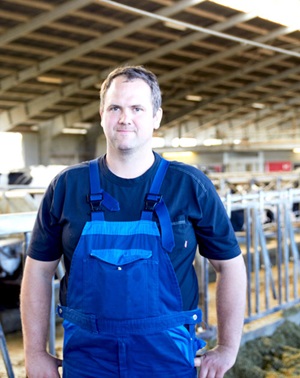Dry Cows Now Keenly In Focus
By Tenna Bang, Effektivt Landbrug
Ten years ago, Brian Bech returned home, back to Drengsted near Skærbæk. He entered into a partnership (I/S) with his parents and now runs Kotel I/S with 485 cow-years and 550 hectares of land.
A few years ago, Brian Bech decided to focus on dry cows, because he felt that too many of them were developing milk fever and underperforming after calving. Over many years, the dry-cow ration comprised a simple maize compound with straw.
“It seemed to work well enough, but we had a number of cows who developed milk fever, also subclinical, with several requiring treatment. This was widespread sometimes and it was stressful for them, especially when the housing system was under pressure,” Brian Bech explains.
He decided to start feeding according to the Low CAB strategy and quickly saw an effect, but still saw a few cases of milk fever each month. At the same time, blood samples showed that a number of cows had subclinical milk fever. This prompted him to shelve the strategy after six months.
He had to do something different. Brian Bech deliberately chose to start over and wipe the slate clean. He made a simple grass and maize compound and added X-Zelit.
“I had to get back to basics, so I decided to double down on my dry cow efforts.”
Far-off and close-up feeding
At the farm, he practises “far-off” and “close-up” feeding.
Brian Bech mixes a basic dry-cow ration with a maize/grass ratio of around 60–40. Some of the basic ration is fed to the dry cows furthest from calving (far off) after which more energy is added in the form of soy and X-Zelit. This is fed to the dry cows closest to calving (close-up).
 Brian Bech feeds the close-up ration to cows that are roughly 15–22 days from calving.
Brian Bech feeds the close-up ration to cows that are roughly 15–22 days from calving.
He also feeds calving heifers the dry cows’ basic ration (the close-up compound) before admixing X-Zelit.
He mixes feed every day, compared to every two days previously.
“I’m not going to compromise any longer,” Brian Bech says.
At Kotel I/S near Skærbæk, they're experiencing how the cows get through the dry period better and get off to a better lactation process. The farm started using X-Zelit a year ago and only three cows have developed milk fever since then.
Grass as a source of protein
The biggest difference between the Low CAB and X-Zelit compounds is that he now adds grass silage to the X-Zelit compound as a source of protein. This means that he has replaced the previous 4 kilos of rapeseed and soy with 0.7 kilos in the basic ration and an additional 1.5 kilos in the close-up compound.
And it works, even if Brian Bech had to shake an old habit the first time he poured grass into the feed mixer and later unloaded the feed in front of the dry cows.
“My dry cows have never been able to tolerate grass. But they can when it contains X-Zelit. We’ve been using the product for a year now, and we’ve only had three cases of milk fever since then. At the same time, blood samples show that those with subclinical milk fever are also well under control,” he says.
Resting strategy
At Kotel I/S, which uses a robotic milking system, the cows are dried out 47–57 days before calving, depending on the cow’s yield.
“If a cow is giving 35 kg of milk, I wait a week. By then its yield will have fallen to 28 kg after a week without high-performance feed,” he explains.
The cows calve when they are in the ‘close-up’ group. After calving, the heifers spend roughly 24 hours in the dry-cow area and are milked in the former dairy barn. The cows spend two to four days in the old cowshed before being transferred to the robotic milking system. As soon as a cow or heifer calves, she is fed cow feed.
“If a cow stands over near the cowshed braying, she is ready to be brought over there, but if she is lying down chewing her cud, she gets to wait. Usually cows that are calving for the second time wait 48 hours and cows calving for the third or fourth time wait three or four days,” Brian Bech says, adding:
“In fact, this means we never see any ketosis.”
Focus shift
Brian Bech experiences that the cows get through the dry period better and get off to a better start after calving, and he is convinced that three factors are responsible for this:
“I’m convinced that X-Zelit works but I think that changing my focus has probably been even more important. At the same time, the dry-cow ration resembles cow feed, and the cows don’t experience the same abrupt feed change that they used to,” he explains.
The new dry-cow strategy has generally calmed down the cowshed.
“At the same time, I no longer have failing cows,” he says.
Back to basics
Previously all cows were given a ‘shot’ of water, sodium bicarbonate and propylene glycol through a pump shortly after calving to get them off to a better start. He doesn’t have to this any longer either.
“You can spend lots of time and money on doing this and that, and everything often gets too complicated, so I’m pleased I started over and went back to basics,” Brian Bech explains.
And the cost of X-Zelit? It doesn’t really matter to Brian Bech.
“All the cost has done is to make me want to be more precise when I mix the feed. I’m keenly aware of how many kilos they eat because it’s just too expensive to toss it out. Also, I spent money on all sorts of things before, which I don’t any longer. Everything is simpler now,” he says.
For more information on X-Zelit, click here.

